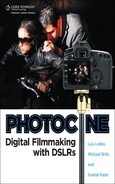Book Description
The advent of the inclusion of high-definition video capabilities in SLR cameras has resulted in a radical leap forward for the photography industry. This simple innovation is bringing photographers to the gates of Hollywood with the potential to create influential commercials and short films without having to secure a studio movie deal. This book offers photographers the definitive guide to confidently move forward into this awesome new genre as they retool their skill set to meet the industry demand for DSLR video, From the technical aspects of setting up your camera, to getting the right gear, to learning to write a treatment, this book is here to demystify DSLR filmmaking. The book includes interviews with some of Hollywood's best-known names, such as cinematographer Gale Tattersall, writer Craig Titley, Executive Producer Greg Yaitanes of TV's House M.D., and rock-and-roll photographer Greg Watermann, as well as tips from Shane Hurlbut, ASC. Welcome to filmmaking for photographers, and anyone else who wants to shoot DSLR video.
Table of Contents
- Copyright
- About the Authors
- Introduction
- 1. HDSLR Camera History
- 2. Achieving the Film Look
- 3. Limitations of Using HDSLRs in Filmmaking
- 4. Lenses
- 5. Monitor Overview
- 6. Support Systems
- 7. Sound
- 8. Understanding Formats and Codecs
- 9. Camera Setup: Canon 5D Mark II for Video
- 10. On-Set File Handling
- 11. Getting into the Edit
- 12. Transcoding and Encoding for Ingestion and Output
- 13. Video Editing
- 14. Finishing Work
- 15. Crafting the Story
- 16. Writing a Great Treatment
- 17. Writing a Screenplay
- 18. Directing
- 19. Breaking into Motion Photography
- 20. One Man, One Camera, and the Video That Started a Paradigm Shift
- 21. Avoiding Overproduction and Clichés
